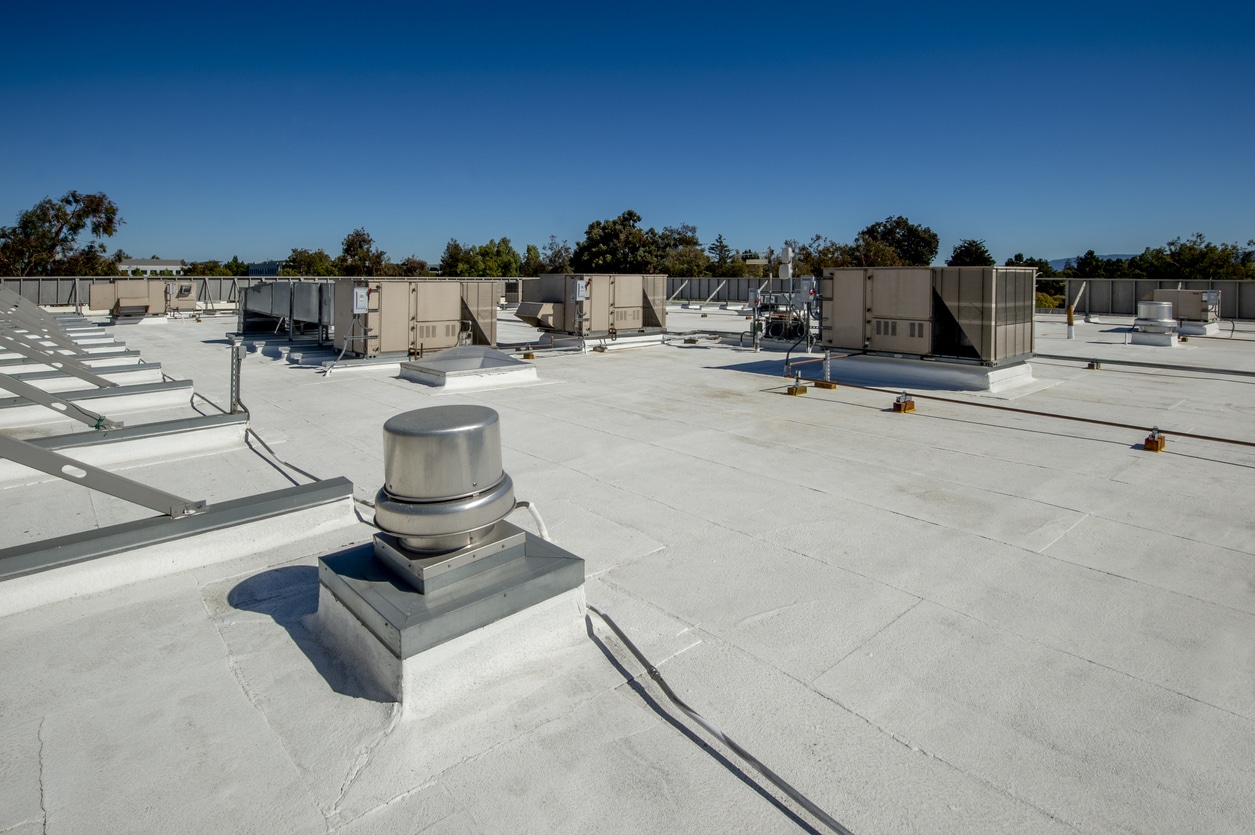
Imagine standing in your living room on a rainy Atlanta afternoon, listening to the steady downpour outside. For most homeowners, the sound of rain should be calming, but for those with a flat or low-slope roof, it often brings a nagging worry. Will the roof hold up this time, or will water find its way in again? Atlanta’s climate makes these fears real. Long stretches of scorching sun, heavy humidity, and sudden storms put enormous stress on roofing systems that were never designed for such conditions.
That is where membrane roofing comes in. Unlike traditional shingles that depend on overlapping layers and gravity to shed water, a membrane roof creates a continuous waterproof barrier across the entire surface. It is designed specifically for flat and low-slope roofs where water tends to pool and where shingles simply do not perform.
Homeowners in Atlanta have several options when it comes to choosing a membrane material. Rubber systems like EPDM, reflective thermoplastics such as TPO and PVC, asphalt-based modified bitumen, and even advanced inverted roof designs all offer unique strengths. The challenge is knowing which one can stand up to the heat, humidity, and storms while also fitting your budget and long-term goals.
At Mr. Roofer, we understand those challenges and are here to help you navigate them with confidence.
What Is a Membrane Roof?
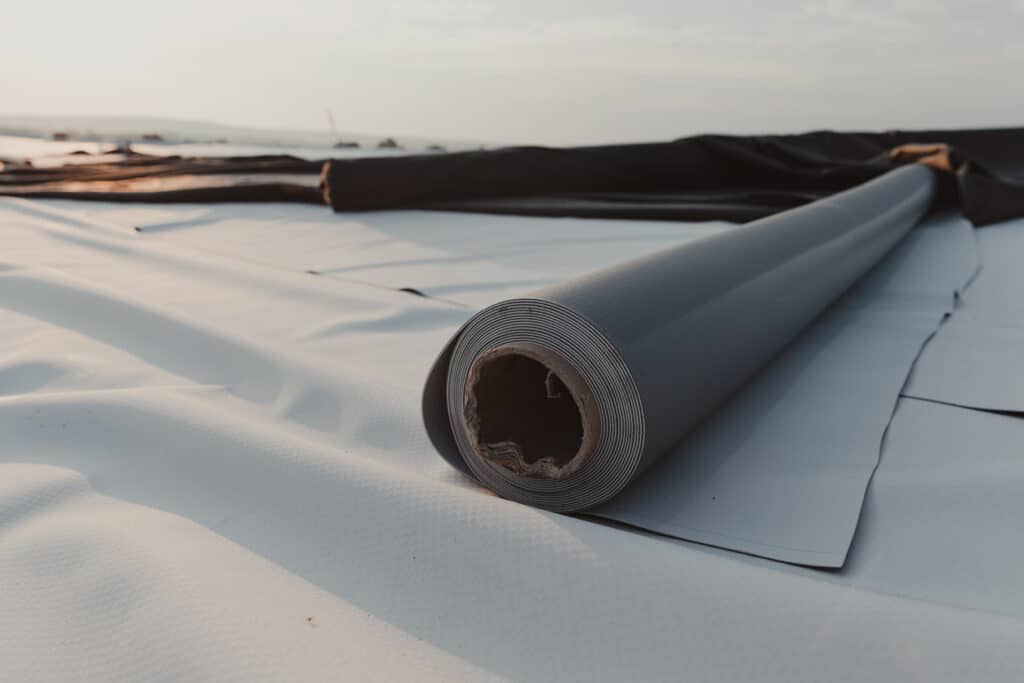
A membrane roof is a specialized roofing system designed to provide a seamless, waterproof barrier for flat and low-slope roofs. Unlike traditional shingles, which rely on overlapping layers to shed water, a roof membrane forms a continuous sheet that completely seals the surface, preventing leaks and water intrusion. This makes it especially effective in areas like Atlanta, where heavy rainstorms, high humidity, and occasional strong winds put roofs to the test.
Membrane roofing works by creating a protective layer that resists water penetration while also standing up to UV rays, heat, and weather-related wear. These systems are engineered to be flexible, so they can expand and contract with temperature changes without cracking or splitting. Because of this adaptability and durability, membrane roofs have become the standard solution for modern commercial buildings and increasingly for residential properties with flat or low-sloped designs.
Benefits Over Shingles for Low-Slope and Flat Roofs
Shingles are designed for steep-slope roofs where gravity helps water run off quickly. On a low-slope or flat roof, however, water tends to pool, and shingles are not effective at keeping moisture out over time. A membrane roof solves this problem by providing a single, watertight layer that resists standing water. This reduces the risk of leaks, rot, and mold damage.
For homeowners, the result is greater peace of mind, longer-lasting protection, and less maintenance compared to patching leaks or replacing shingles that fail prematurely on low-slope surfaces.
Common Roof Membrane Materials
Roof membranes come in several material types, each with unique advantages. The most common include:
- Rubber (EPDM): A synthetic rubber membrane known for its affordability, durability, and ease of installation. It performs well in a variety of climates and offers excellent resistance to UV rays.
- Thermoplastics (TPO and PVC): These membranes are heat-welded to form airtight seams, creating an exceptionally strong waterproof barrier. TPO is energy-efficient, reflecting sunlight to reduce cooling costs, while PVC offers superior chemical resistance and long service life.
- Asphalt-Based (Modified Bitumen): Made by reinforcing asphalt with polymers and fabrics, this material provides toughness and flexibility. Modified bitumen membranes can be applied in multiple layers, giving them added durability against punctures and heavy foot traffic.
Together, these materials give homeowners a range of options to fit different budgets, performance needs, and design considerations. When installed properly, any of these membranes can provide decades of reliable waterproofing for Atlanta homes.
Types of Flat Roof Membranes Used in Atlanta
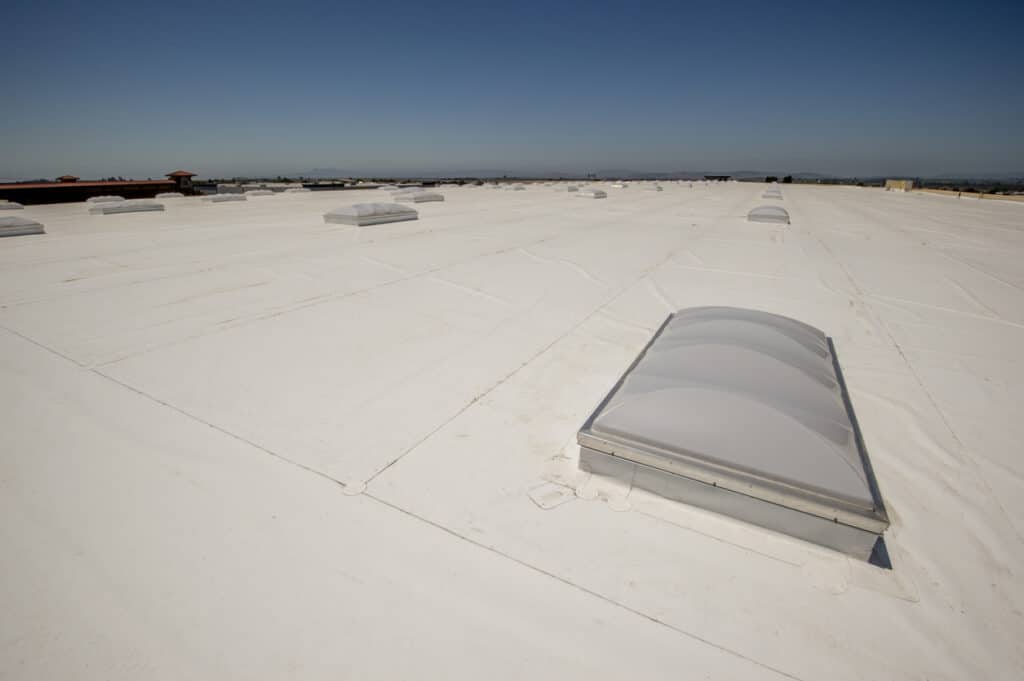
Flat and low-slope roofs face unique challenges in Atlanta’s climate. Intense summer heat, high humidity, frequent heavy rains, and occasional severe storms mean that roofing systems must be both waterproof and resilient. Unlike pitched roofs where shingles can shed water quickly, flat roofs are more prone to pooling, which makes the choice of membrane critical. Homeowners need a roofing solution that balances durability, energy efficiency, cost, and ease of maintenance.
Below are the primary types of flat roof membranes used in Atlanta, each with distinct strengths and drawbacks.
EPDM Rubber Membrane Roofing
EPDM (ethylene propylene diene monomer) is a synthetic rubber membrane widely recognized as one of the most reliable and time-tested flat roof materials. It is manufactured in large rolls, which can reduce the number of seams required on the roof surface.
Key Strengths:
- Longevity: With proper care, EPDM can last 25 to 30 years, making it one of the longest-lasting membrane systems.
- Flexibility: The rubber composition expands and contracts easily, reducing stress cracks caused by Atlanta’s hot days and cooler nights.
- UV resistance: It stands up well against constant sun exposure, slowing down degradation.
Considerations:
- Heat absorption: Standard black EPDM absorbs significant heat, which can increase indoor cooling demands in summer. White EPDM coatings are available to mitigate this.
- Seams: Because seams are adhered with tape or adhesives instead of heat-welded, they can be more vulnerable to water penetration if installation quality is poor.
- Maintenance: While durable overall, EPDM roofs benefit from regular inspections to ensure seam integrity and to spot any punctures caused by falling branches or debris.
TPO Membrane Roofing Material
TPO (thermoplastic polyolefin) is a relatively newer material that has gained strong popularity in residential and commercial flat roofing. It is a single-ply membrane typically installed in white, which reflects sunlight effectively.
Key Strengths:
- Energy efficiency: Its reflective surface helps reduce cooling costs by minimizing heat absorption, a significant advantage in Atlanta’s hot, sunny summers.
- Cost-effectiveness: TPO is generally less expensive than PVC while offering many similar benefits.
- Seam strength: Heat-welded seams form airtight, watertight bonds that are less prone to leaks compared to glued seams.
Considerations:
- Quality variation: Different manufacturers produce TPO with varying formulations, which can impact durability. This makes choosing an experienced contractor and high-quality material critical.
- Lifespan: While TPO roofs typically last 15 to 20 years, their longevity can be shorter if low-quality material is used or installation is rushed.
- Weathering: Prolonged exposure to standing water or extreme UV conditions may affect performance if not properly maintained.
PVC Roofing Membrane
PVC (polyvinyl chloride) is another thermoplastic membrane and is considered one of the most premium options for flat and low-slope roofs. It has been used for decades in both residential and commercial applications.
Key Strengths:
- Durability: PVC membranes are highly resistant to moisture, fire, and chemicals. This makes them ideal for roofs exposed to heavy rain, ponding water, or environmental pollutants.
- Strong seams: Like TPO, PVC membranes are heat-welded, creating superior seam strength and leak resistance.
- Longevity: PVC roofs often last 20 to 30 years, providing long-term value for homeowners.
- Versatility: Suitable for both residential and commercial buildings, especially where energy efficiency and strength are priorities.
Considerations:
- Higher cost: PVC generally costs more than TPO or modified bitumen, making it a larger upfront investment.
- Brittle aging: Over time, older PVC formulations may become brittle if not properly maintained, although modern blends have improved flexibility.
Modified Bitumen Membrane Roofing
Modified bitumen combines asphalt with polymer modifiers to create a flexible, durable membrane. It can be installed using several methods, including torch-applied, self-adhered, or cold-applied systems.
Key Strengths:
- Durability: Modified bitumen is puncture-resistant and holds up well to foot traffic, making it suitable for roofs that double as accessible outdoor spaces.
- Multi-layer protection: It can be applied in multiple plies, which enhances waterproofing and resilience.
- Proven system: As an evolution of built-up roofing, modified bitumen benefits from decades of use and refinement.
Considerations:
- Shorter lifespan: Modified bitumen typically lasts 15 to 20 years, which is shorter than PVC or EPDM.
- Heat absorption: Dark-colored surfaces absorb more heat, unless a reflective coating is added.
- Installation complexity: Torch-applied methods can be risky and must be handled by trained professionals to avoid fire hazards.
Built-Up Roofing (BUR) Membranes
Built-up roofing is one of the oldest and most traditional flat roofing systems. It is constructed by alternating layers of asphalt or tar with reinforcing fabrics, then topped with gravel or a reflective coating.
Key Strengths:
- Proven reliability: BUR has been used for over a century and provides a thick, multi-layered waterproof barrier.
- Weather resistance: The gravel surface protects against UV rays and helps weigh down the system against strong winds.
- Strong waterproofing: Multiple layers create redundancy, so if one layer is compromised, others still protect the structure.
Considerations:
- Heavy weight: BUR systems are significantly heavier than single-ply membranes, requiring extra structural support.
- Labor-intensive installation: BUR takes longer to install and often comes with higher labor costs.
- Declining popularity: In modern Atlanta homes, BUR is less common due to its weight and complexity, though it remains in use for some commercial properties.
Inverted Roof Systems (IRMA Roof) in Atlanta
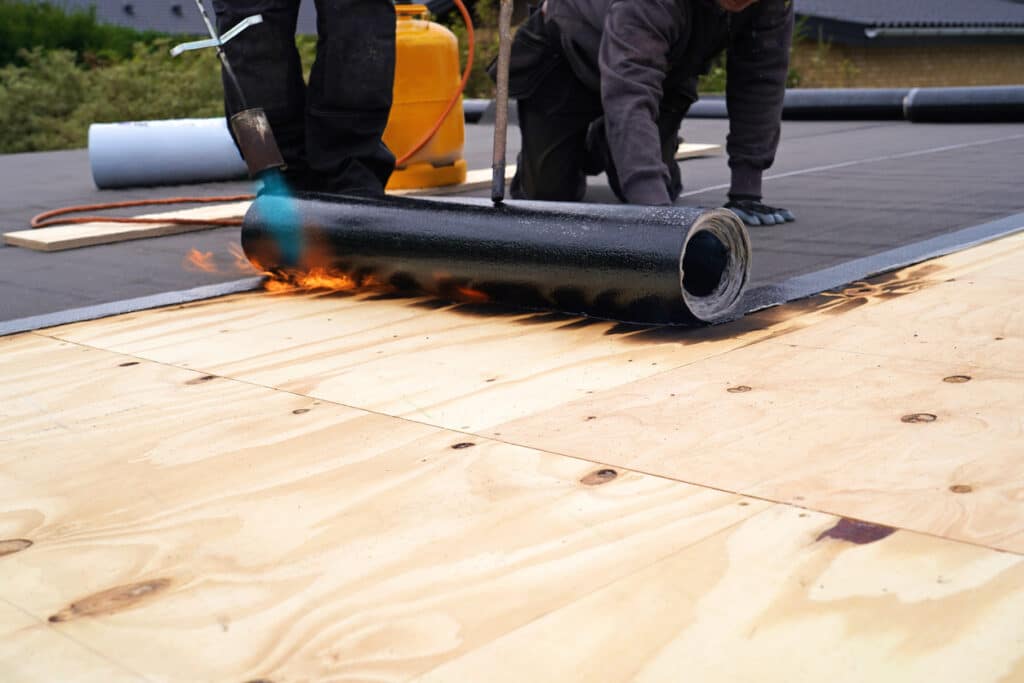
An inverted roof system, often called an IRMA roof, is a specialized flat roofing design where the insulation is placed above the waterproofing membrane instead of below it. In this setup, the membrane is installed directly on the roof deck, then covered with a layer of rigid insulation, followed by ballast such as gravel, pavers, or a green roof system. This design flips the traditional order of roof components, which is why it is known as an inverted system.
By moving insulation above the membrane, the roof design shields the waterproofing layer from direct exposure to harsh weather and physical damage. This approach is increasingly used in energy-efficient and sustainable roofing projects because of its durability and performance benefits.
Advantages of IRMA Roofs in Atlanta
Atlanta’s climate presents a unique challenge for flat roofs, with high summer temperatures, intense UV radiation, humidity, and heavy rainfall. An inverted roof system offers significant advantages in these conditions, including:
- Membrane protection from UV rays: Since the waterproofing layer is buried beneath insulation and ballast, it is not exposed to the sun, reducing the risk of UV degradation.
- Reduced thermal stress: The insulation above the membrane shields it from extreme heat during the day and cooler temperatures at night, preventing premature cracking or splitting.
- Extended lifespan: Protected from environmental stressors and physical wear, the waterproofing membrane typically lasts much longer than in traditional systems.
- Lower cooling costs: Because the insulation is on top, heat is blocked before reaching the building, improving energy efficiency during Atlanta’s hot summers.
- Resistance to storm damage: The ballast layer adds weight that helps anchor the roof system during strong winds or severe storms common in the region.
Best Applications for IRMA Roofs
Inverted roof systems are best suited for projects that require long-term durability and high performance. They are often used in:
- Energy-efficient homes: IRMA roofs enhance thermal performance and reduce reliance on air conditioning, an important advantage in Atlanta’s humid climate.
- Green roofs and rooftop gardens: Because the waterproofing layer is protected beneath insulation, these roofs are ideal for supporting vegetation or rooftop outdoor spaces.
- Commercial and high-end residential properties: Buildings that prioritize sustainability, longevity, and reduced maintenance costs benefit most from the IRMA system.
Although IRMA roofs typically require a higher initial investment, their extended lifespan and energy savings often offset the upfront cost, making them a strategic choice for homeowners who view their roof as a long-term investment.
Choosing the Best Roof Membrane for Atlanta Homes
Selecting the right roof membrane is one of the most important decisions a homeowner with a flat or low-slope roof can make. Atlanta’s climate, with its hot summers, high humidity, frequent rain, and occasional severe storms, places unique demands on roofing systems. The right material can mean decades of protection, while the wrong choice may lead to costly repairs and higher energy bills.
Key Factors to Consider in Atlanta
When evaluating roof membranes for your home, it helps to weigh the following factors:
- Heat exposure: Atlanta summers bring long stretches of intense sunlight, which can accelerate membrane wear and increase cooling costs. Materials with reflective or coated surfaces can make a noticeable difference.
- Humidity: Constant moisture in the air puts added stress on roofing systems, especially at seams or weak points where leaks may form.
- Heavy rain: Flat roofs often experience pooling water after storms. Membranes must be fully waterproof and resistant to ponding.
- Storm exposure: Strong winds and debris during thunderstorms or tropical systems can puncture or tear weaker membranes. A system with strong seam bonding and puncture resistance is critical.
Comparing Common Roof Membrane Options
Each membrane type offers advantages and trade-offs. Below is a closer look at how the main options perform in Atlanta’s environment.
Membrane Type | Lifespan | Strengths | Weaknesses | Best Fit |
EPDM Rubber | 2530 years | Long lifespan, excellent UV resistance, flexible in temperature changes | Dark color absorbs heat, seams are adhered and more prone to leaks | Homeowners seeking affordability and proven durability |
TPO Membrane | 1520 years (longer for premium) | Highly reflective and energy efficient, cost-effective, strong heat-welded seams | Quality varies between manufacturers, performance depends on installation | Homeowners prioritizing energy efficiency and moderate budget |
PVC Membrane | 2030 years | Excellent waterproofing and chemical resistance, superior seam strength, handles ponding water well | Higher upfront cost | Long-term homeowners who want premium durability and low maintenance |
Modified Bitumen | 1520 years | Reinforced for puncture resistance, durable under foot traffic, proven asphalt-based system | Dark surface absorbs heat, shorter lifespan than TPO or PVC | Roofs with frequent access or homeowners seeking toughness at a lower cost |
Recommendations for Atlanta Homeowners
When balancing budget, performance, and lifespan, homeowners in Atlanta should consider the following guidance:
- Best for budget-conscious projects: EPDM and modified bitumen provide reliable waterproofing at lower upfront costs, though they may require more frequent maintenance.
- Best for energy efficiency: TPO is a strong choice thanks to its reflective white surface, helping keep homes cooler during long summer months.
- Best for durability and longevity: PVC offers the strongest overall protection against water, UV rays, and chemical exposure, making it a worthwhile investment for homeowners planning to stay in their property long-term.
- Best for specialized or premium applications: IRMA roofs or PVC systems are ideal for green roofs, high-end residences, or projects where extended lifespan and energy savings are the priority.
In the end, the best roof membrane for an Atlanta home depends on striking the right balance between initial cost, expected service life, and how well the system can stand up to the city’s heat, humidity, and stormy weather. Working with an experienced roofing contractor ensures that whichever membrane is chosen, it will be installed to perform at its full potential.
Cost and Lifespan of Roof Membrane Materials
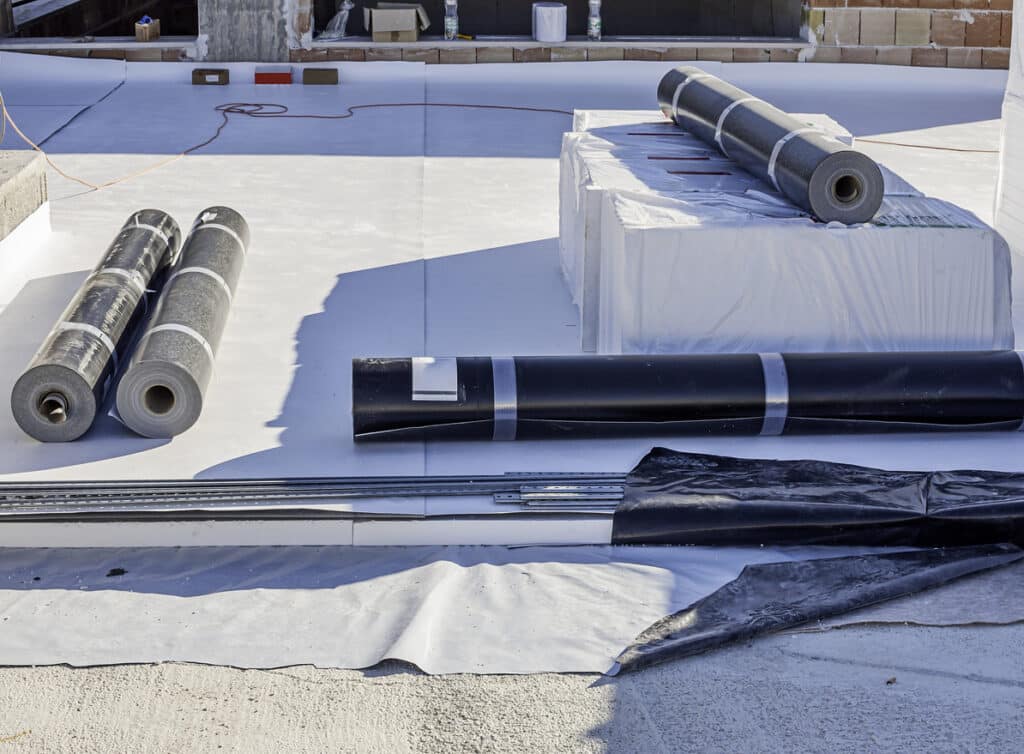
For homeowners in Atlanta, the cost and expected lifespan of a roof membrane are two of the most important factors when planning a roofing project. While the upfront price matters, the long-term value of each material depends on how well it withstands the region’s hot summers, heavy rainfall, and occasional storms.
General Cost Ranges
The price of roof membranes varies depending on material type, roof size, installation complexity, and contractor expertise. On average, Atlanta homeowners can expect the following ranges per square foot:
- EPDM Rubber Membrane: $4 to $8 per square foot, making it one of the most cost-effective options.
- TPO Membrane: $5 to $9 per square foot, slightly higher than EPDM but with added energy efficiency benefits.
- PVC Membrane: $7 to $12 per square foot, reflecting its premium durability and performance.
- Modified Bitumen: $4 to $8 per square foot, similar to EPDM in cost but suited for roofs with frequent foot traffic.
- Built-Up Roofing (BUR): $6 to $12 per square foot, typically higher because of labor and material intensity.
These estimates include both material and professional installation, though costs may increase for more complex roof structures or specialized designs such as green roofs.
Typical Lifespans in Atlanta’s Climate
Lifespan is where roof membranes show their true differences, especially in Atlanta’s demanding environment.
- EPDM Rubber Membrane: 25 to 30 years with regular maintenance.
- TPO Membrane: 15 to 20 years, though high-quality products may last longer.
- PVC Membrane: 20 to 30 years, offering one of the longest service lives.
- Modified Bitumen: 15 to 20 years, often shorter without reflective coatings.
- Built-Up Roofing (BUR): 20 to 25 years, though lifespan depends on installation quality and upkeep.
Heat, humidity, and UV exposure in Atlanta can shorten the life of poorly installed or low-quality membranes. Choosing a trusted contractor is essential to maximize longevity.
Long-Term Value Considerations
The initial price of a roof membrane tells only part of the story. Long-term value comes from balancing upfront savings with durability, energy efficiency, and maintenance needs.
- Budget-friendly systems like EPDM and modified bitumen save money at installation but may require more frequent repairs or earlier replacement.
- Mid-range options like TPO strike a balance between cost and performance, offering energy efficiency that can reduce cooling bills in Atlanta’s hot summers.
- Premium options like PVC and IRMA roof systems cost more upfront but deliver extended lifespans, strong resistance to ponding water, and lower long-term maintenance, making them ideal for homeowners planning to stay in their homes for decades.
For many homeowners, the best value lies not just in the lowest price per square foot but in how well the chosen system performs year after year against Atlanta’s weather challenges.
Here’s a clear cost vs. lifespan value table to show which roof membranes give the best return on investment for Atlanta homes:
Roof Membrane Type | Cost Range (per sq. ft.) | Typical Lifespan | Value Summary |
EPDM Rubber | $4 $8 | 25 30 years | Low upfront cost and long lifespan make EPDM one of the most cost-effective options for homeowners seeking durability without a premium price. |
TPO Membrane | $5 $9 | 15 20 years | Moderate cost with energy savings from reflectivity. Good value for budget-conscious homeowners focused on reducing cooling bills, though lifespan is shorter. |
PVC Membrane | $7 $12 | 20 30 years | Higher upfront cost offset by excellent durability, strong waterproofing, and low maintenance. Best long-term value for homeowners planning to stay in their home for decades. |
Modified Bitumen | $4 $8 | 15 20 years | Affordable installation and tough against foot traffic, but shorter lifespan limits long-term value compared to EPDM or PVC. |
Built-Up Roofing (BUR) | $6 $12 | 20 25 years | Strong waterproof protection with proven performance, but higher labor costs and heavy weight make it less attractive for residential use today. |
Conclusion
For homeowners in Atlanta, membrane roofing provides the dependable waterproof protection that flat and low-slope homes require. With options like EPDM, TPO, PVC, modified bitumen, and even advanced IRMA roof systems, there is a solution for every budget and performance need. The key is finding the right balance between upfront cost, long-term durability, and energy efficiency to withstand Atlanta’s heat, humidity, and heavy rains.
Because every home is different, the best choice often depends on unique factors such as roof design, how the space will be used, and long-term goals for energy savings. That is why working with an experienced local contractor is essential. A trusted Atlanta roofing expert can evaluate your home, explain the trade-offs of each system, and guide you toward the option that offers the best return on your investment.
If you are considering a new roof or replacement for your flat or low-slope home, contact Mr. Roofer today. Our team understands the challenges of Atlanta’s climate and will help you choose a roof membrane that delivers lasting protection, comfort, and peace of mind.
